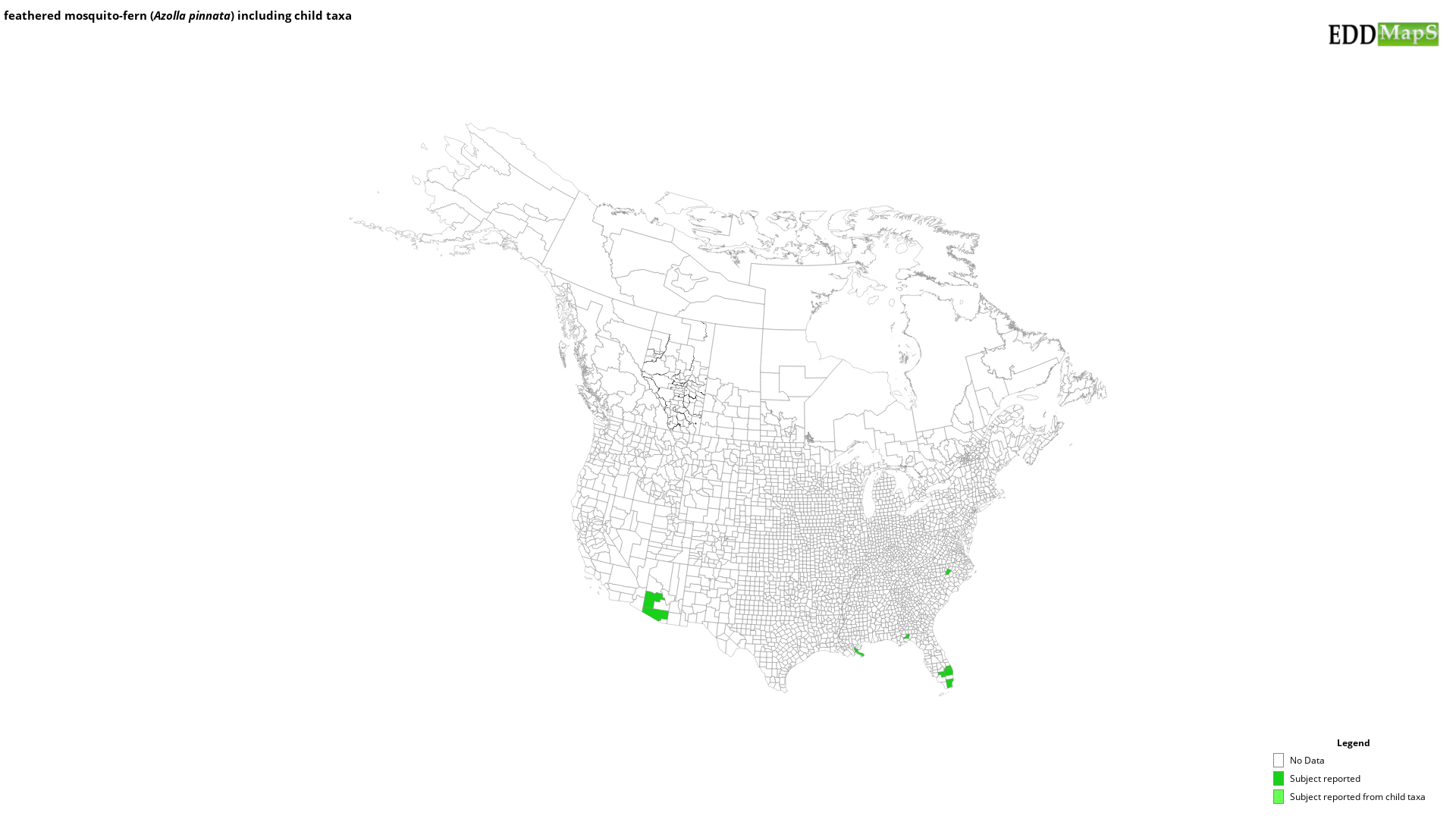feathered mosquito-fern
(Azolla pinnata)
This species is a Cultivar and may be non-native across its range in the United States
Origin
Native to Africa, India, Southeast Asia, China, Japan, Malaysia, the Philippines, New Guinea and Australia.
Appearance
Azolla pinnata is a small, free-floating, annual aquatic fern. Individual plants are approximately 0.5-1" (1.5-2 cm) long clustered together to form large mats. Rootlets are up to 2" (5 cm) long with root hairs that give a feathery appearance in water.
Foliage
Leaves are tiny, only 1-2 mm long, oval, scale-like and overlapping in 2 rows; the 2-lobed upper part is green, brown-green or maroon-red, with tiny hairs; the lower part is translucent brown.
Fruit
Spore cases (called sporocarps), which contain numerous spores, are very small and may be visible under the plant at the base of fronds. The fronds are lobed and on side-branches.
Ecological Threat
Quiet waters of ponds and lakes; prefers shallow waters but will also grow in deeper water. Plants tolerate a wide range of water and air temperatures but cannot survive drought longer than a few days.
Citation
Angelo, C., Cooley, H., Giardina, D., et al. 2019. Everglades CISMA: Early Detection, Rapid Response Plant Species. Florida Exotic Pest Plant Council (FLEPPC) CISMA and Friends of Everglades CISMA. Retrieved from https://bugwoodcloud.org/mura/ECISMA/assets/File/ECISMA_plantEDRR_.pdf
Native to Africa, India, Southeast Asia, China, Japan, Malaysia, the Philippines, New Guinea and Australia.
Appearance
Azolla pinnata is a small, free-floating, annual aquatic fern. Individual plants are approximately 0.5-1" (1.5-2 cm) long clustered together to form large mats. Rootlets are up to 2" (5 cm) long with root hairs that give a feathery appearance in water.
Foliage
Leaves are tiny, only 1-2 mm long, oval, scale-like and overlapping in 2 rows; the 2-lobed upper part is green, brown-green or maroon-red, with tiny hairs; the lower part is translucent brown.
Fruit
Spore cases (called sporocarps), which contain numerous spores, are very small and may be visible under the plant at the base of fronds. The fronds are lobed and on side-branches.
Ecological Threat
Quiet waters of ponds and lakes; prefers shallow waters but will also grow in deeper water. Plants tolerate a wide range of water and air temperatures but cannot survive drought longer than a few days.
Citation
Angelo, C., Cooley, H., Giardina, D., et al. 2019. Everglades CISMA: Early Detection, Rapid Response Plant Species. Florida Exotic Pest Plant Council (FLEPPC) CISMA and Friends of Everglades CISMA. Retrieved from https://bugwoodcloud.org/mura/ECISMA/assets/File/ECISMA_plantEDRR_.pdf
Resources
- Global Invasive Species Database - Invasive Species Specialist Group
- Pacific Island Ecosystems at Risk - USDA Forest Service
- Federal Noxious Weed Disseminules of the U.S. - USDA-APHIS
Selected Images
Maps
EDDMapS Distribution - This map is incomplete and is based only on current site and county level reports made by experts, herbaria, and literature. For more information, visit www.eddmaps.org
State Lists - This map identifies those states that have this species on their invasive species list or law.
Invasive Listing Sources
- Federal Noxious Weeds
- Idaho Noxious Weeds
- Indiana Invasive Species Council - Invasive Plant List
- Indiana Pest Species
- Indiana Prohibited Plant Species
- Massachusetts Noxious Weeds
- Massachusetts Prohibited Plant List
- Nonnative Invasive Species in Southern Forest and Grassland Ecosystems
- Ontario’s Invading Species Awareness Program Tracked Species List
- South Carolina Illegal Aquatic Plants
- South Carolina Plant Pest List
- USDA APHIS Regulated Pest List
- Wisconsin Noxious Weeds
- Wisconsin's Invasive species rule – NR 40
Taxonomic Rank
| Domain: Eukarya |
| Kingdom: Plantae |
| Division: Pteridophyta |
| Class: Filicopsida |
| Order: Salviniales |
| Family: Salviniaceae |
| Genus: Azolla |
| Azolla pinnata |
References
Common Name Reference: Weed Science Society of America Common Names List
Scientific Name Reference: USDA, NRCS. 2010. The PLANTS Database. National Plant Data Center, Baton Rouge, LA, USA.


